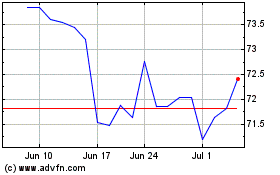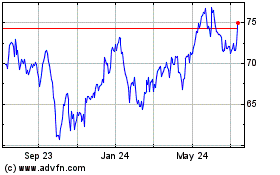By Tim Mullaney
If investors had to sum up utility stocks in a word, many would
probably say "predictable."
Known for having above-average dividends and stable earnings in
all kinds of markets, these investments tend to attract investors
seeking to play defense rather than pursue growth.
But some money managers say the sector could become less
predictable in coming years, maybe even a little exciting. The
global focus on climate change is shaking up the industry, they
say, and the U.S. presidential election could shake it up even
more.
So far this year, utility stocks have lagged behind the broader
market, hurt by a sharp drop in electricity demand in the first
half of 2020 amid the coronavirus lockdowns. While the S&P 500
has returned around 8.25% year to date, the utility stocks in the
index have fallen almost 1%. The S&P utilities sector had risen
33.7% from year end 2018 to the 2020 high set on Feb. 18.
Some investors say utility shares are still too expensive, but
others say the industry is in the midst of a transition that could
give utiity shares a boost.
Utilities, they say, are pouring billions of dollars into new
plants to generate electricity from renewable sources such as wind
and sunlight -- and preparing for new demand as the nation's auto
and truck fleets shift from running on petroleum products to clean
electricity. The move toward renewable power could accelerate if
Joe Biden wins the U.S. presidential election in November, analysts
say, as the Democratic nominee has proposed extending tax credits
to promote the adoption of green technologies.
The result, some of the sector's fans say, is that savings on
fuel could enable utilities to boost profits and remain solid
dividend payers, even as consumers are spared major increases in
electric bills.
"Investors have to think about utilities differently," says Rob
Thummel, senior portfolio manager at Tortoise Capital, which runs a
series of energy portfolios, including the $9.1 million mutual fund
Tortoise Energy Evolution Fund (TOPTX). "There's more potential for
growth than there has been."
Wind and sun
U.S. utilities are on course to build 100,000 megawatts of new
wind and solar-powered electricity plants over the next 15 years,
enough to replace almost 10% of all of the power produced today,
according to S&P Global Market Intelligence.
The expanding roster of power companies vowing to reduce carbon
emissions includes Minneapolis-based Xcel Energy, a leader in
building wind power plants. Xcel has promised to cut carbon
emissions 80% by 2030 and to be carbon-free by 2050. American
Electric Power, the Columbus, Ohio-based utility that delivers
power to customers in 11 states, has pledged an 80% reduction by
2050, and Edison International, the parent of Southern California
Edison, vows to do the same by 2030.
The shift to renewable power in the U.S. would likely speed up
if Mr. Biden wins, analysts say. He has pledged to rejoin the Paris
Climate Accord as part of a broader $1.7 trillion plan to combat
climate change and promised to make electricity carbon-neutral by
2035. In 2017, President Trump withdrew the U.S. from the Paris
accord, which calls on the U.S. to commit to reducing
greenhouse-gas emission 26% to 28% from 2005 levels by 2025.
"We have an underweight recommendation on the sector based on
fundamental forecasts and price momentum, but that could change
with a Biden-Harris victory," says CFRA Research investment
strategist Sam Stovall.
Pricey or not?
Others, however, believe utility stocks are still too expensive.
Who is right depends on which metric you look at, says Morningstar
utility analyst Travis Miller.
On a price-to-earnings basis, they are expensive. The S&P
utility sector was recently trading at about 19 times this year's
earnings and 18 times 2021 estimates, compared with 25 times and 20
times for the S&P 500.
But utilities traditionally trade at a discount because of their
lower growth rate, which for many investors is offset by their
relatively high dividends. Top dividend-paying utilities like Duke
Energy, for example, may offer yields above 4%.
If you compare dividend yields in the utility sector to interest
rates on investments like bonds, they are historically cheap, Mr.
Miller says.
"The returns are good, slow and steady," says Paige Meyer,
utilities analyst at CFRA Research in Washington. "That's why
Warren Buffett likes utilities."
The industry's biggest challenge will be boosting growth, even
if going green helps profit margins, says Ethan Zindler, head of
Americas research at Bloomberg NEF. Along with switching to
renewable power, the big push on climate has been to make buildings
and manufacturing more energy-efficient -- which has pushed
electricity usage in the U.S. below 2008 levels, with a sharp drop
expected as figures come in for 2020, thanks to the lockdowns, he
says.
"The demand numbers haven't fluctuated that much, but more stuff
gets built because it is getting cheaper," Mr. Zindler says. "If I
had to pick a threat to utilities, it's not overinvestment, it's
that demand for the product is not growing."
It all comes down to whether investors, who were used to holding
utilities as a no-fuss investment, will be willing to stick with
them as they continue to go through wrenching change. And whether
utilities, which have been adding renewables rapidly for a decade,
can continue to offset the capital costs of new plants with fuel
savings, which so far has led to electricity prices for most rate
payers declining in inflation-adjusted dollars, according to Labor
Department data.
"This transition should translate into earnings and dividend
growth," Mr. Miller says. "The key is to get customers on board
with any one-time costs that may spring up."
Mr. Mullaney is a writer in Maplewood, N.J. He can be reached at
reports@wsj.com.
(END) Dow Jones Newswires
October 18, 2020 11:14 ET (15:14 GMT)
Copyright (c) 2020 Dow Jones & Company, Inc.
Edison (NYSE:EIX)
Historical Stock Chart
From Mar 2024 to Apr 2024

Edison (NYSE:EIX)
Historical Stock Chart
From Apr 2023 to Apr 2024
